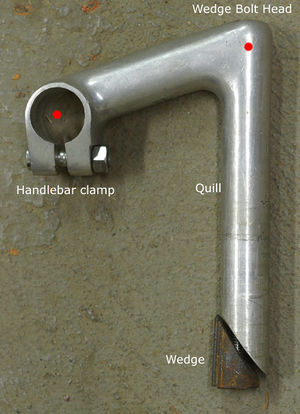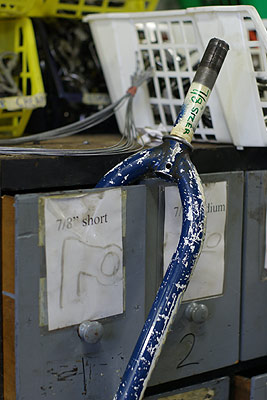Stems
Stems
Evaluating
All a stem needs to work is to have all of its parts and not break. These two things are all you need to check to evaluate a stem.
Parts
This is what a threaded stem looks like. There are two key parts that can get lost. One is the bolt that runs vertically from where the image says "Wedge bolt head" down into the wedge (you can see a bit of its threads). If this bolt is missing, or if it is still there but the wedge is gone, the stem will go into a bucket of incomplete stems; it isn't scrap, but can't be used until someone puts a new part on. The other part is the bolt that holds the handlebar clamp closed. If this is missing, it will go in the same bucket.
Breaking
Most stems are made of aluminum, and since they are under a lot of stress it is possible for them to develop cracks. As with anything aluminum, a stem with a tiny crack in it is scrap and should be throw out right away. However, stems are more likely than most aluminum parts to develop tiny cracks, and you should look carefully around and near the handlebar clamp - this is where you are most likely to find them. No crack is small enough to be ok - any crack makes it scrap.
TODO: Add a few notes and a picture on threadless and removable faceplate.
Sorting
Put simply, stems connect the handlebar to the bicycle. The stems you will find at the co-op will generally be quill stems, like the one in the picture below. The lower part jams into the bicycle frame and the circular hole clamps around the handlebar. Quill stems can vary in three ways, and will generally vary in two ways at the co-op.
Quill Size
One way is the size of the quill - the lower part of the stem can be three different sizes, to fit different types of bicycles. 7/8" stems and 1" stems look similar. As the names indicate, 7/8" stems are slightly smaller than 1" stems. But don't use calipers to measure, because neither one is the size it says, and you will only be confused. You can tell the difference by trying to push the stem into the tube on the stem cabinet labeled "7/8" sizer", pictured to the right. A 7/8" stem will fit, and a 1" stem will not. 1 1/8" (one and one eighth inch) stems are plainly visibly larger.
Length
The second way is the length of the quill and length of the extension (the part of the stem that goes forward to hold the handlebar). At the co-op, we sort stems by the length of the extension, ignoring the length of the quill. The drawers are either sorted by length in millimeters or sometimes by "short" vs. "long". Like with saddles, stem extension lengths are best sorted by comparison to things already in the drawer. In the picture below, the length of the extension is the distance between the two red dots; it is measured "center-to-center".
Clamp Diameter
The third way in which quill stems vary is not one that you will generally encounter at the co-op, but you should know about it. The area where the stem clamps the handlebar can be sized differently. On modern bicycles, "road" handlebars are almost always a slightly larger size than "flat" or "mountain" handlebars, and there is a third size which is even larger that is sometimes used for either type on very expensive bicycles. Almost all stems and handlebars at the co-op are of the smallest of the three sizes, which is 25.4mm, or exactly one inch.
Adjustment
Spanish
Poste de Manubrio (m)
Potencia (f)
|
Bicycle Parts |
|||||
| Ball Bearings • Brakes (Caliper Brakes, Cantilever Brakes & Disc Brakes) • Brake Levers • Chainrings • Chains • Cranks | |||||
| Derailers (Front & Rear) • Forks • Frame • Front Derailers • Handlebars • Hubs • Pedals • Quick Release | |||||
| Rim • Seatposts • Seats • Shifters • Skewer • Spokes • Stems • Tires • Tubes • Wheels |

